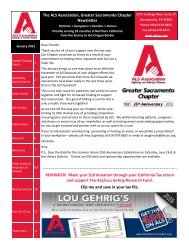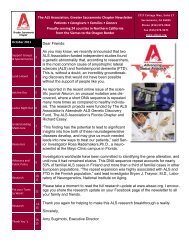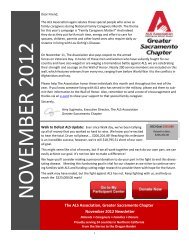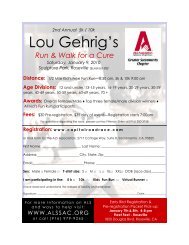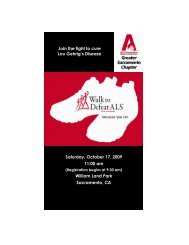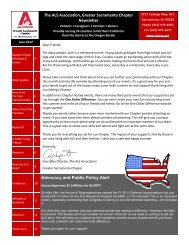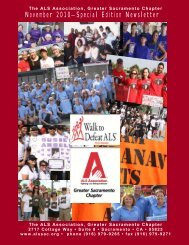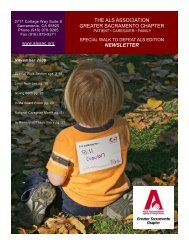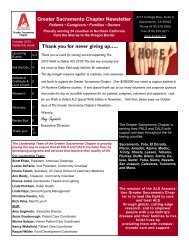April 2011 - The ALS Association Greater Sacramento
April 2011 - The ALS Association Greater Sacramento
April 2011 - The ALS Association Greater Sacramento
Create successful ePaper yourself
Turn your PDF publications into a flip-book with our unique Google optimized e-Paper software.
Page 13<br />
Research: Whole Exome Sequencing Identifies VCP Gene as a Cause of <strong>ALS</strong><br />
“Whole exome sequencing” is a revolutionary technology in gene<br />
discovery, and <strong>ALS</strong> is one of the first neurologic diseases to which<br />
this technique has been applied. “<strong>ALS</strong> is leading the field in this<br />
regard,” said Bryan Traynor, M.D., of the National Institute of Aging,<br />
in a webinar hosted by the <strong>ALS</strong> <strong>Association</strong>.<br />
Dr. Traynor has made significant contributions to the field of <strong>ALS</strong><br />
research, and has been closely involved with <strong>The</strong> <strong>Association</strong> in<br />
guiding <strong>ALS</strong> research funding and project development, noted <strong>ALS</strong><br />
<strong>Association</strong> Chief Scientist Lucie Bruijn, Ph.D., who hosted the webinar.<br />
Over the next two years, Dr. Traynor hopes to perform whole<br />
exome sequencing on blood samples from 400 families with familial<br />
<strong>ALS</strong>. To become part of that exciting research study, see the end of<br />
this article for contact information. Family Studies are the Key to<br />
Rapid Gene Discovery<br />
<strong>The</strong>re are two strategies for finding genes that cause disease, Dr.<br />
Traynor explained, called “cohort studies” and “family studies.” In a<br />
cohort study, the genomes (that is, the entire genetic makeup) of<br />
thousands of individuals are screened, to find small changes, called<br />
variants, which are associated with the disease. Such a study, also<br />
called a “genome-wide association study,” was originally hoped to<br />
be a way of rapidly finding disease genes, but the task is proving<br />
more difficult than once thought. As a result, said Dr. Traynor,<br />
“Everybody is coming back to family studies.”<br />
Family studies were the standard way of finding genes from the<br />
beginning of the gene-hunting era. Family studies were used to find<br />
the first <strong>ALS</strong> gene, SOD1, and the more recent ones TDP-43 and<br />
FUS.<br />
A family study begins with a family, some of whose members have<br />
<strong>ALS</strong> and others who don’t. By comparing their DNA, it is possible to<br />
find a small differences in their DNA that correlate with presence of<br />
the disease. <strong>The</strong> problem with family studies, until quite recently,<br />
was that they required extremely painstaking work, and were therefore,<br />
quite slow. In addition, researchers needed samples from at<br />
least five family members with the disease, a challenge in a rapidly<br />
progressive disease like <strong>ALS</strong>.<br />
All that has changed in the past year, with the development of a<br />
revolutionary new way to do family studies, called “whole exome<br />
sequencing.” This has been made possible by recent progress in<br />
gene sequencing techniques combined with a vast increase in computing<br />
power.<br />
Most Mutations are in Exons<br />
<strong>The</strong> genome is the entire DNA inheritance of a person. But only a<br />
small fraction of the genome encodes proteins, and it is the code for<br />
proteins—the genes—that hold the key to understanding <strong>ALS</strong>. Each<br />
of our 30,000 genes is divided into segments, called exons, about 10<br />
per gene.<br />
“<strong>The</strong> vast majority of the mutations that cause human diseases lie<br />
in the exons,” Dr. Traynor explained. “We know that’s where the<br />
mutations are, and we now have the ability to sequence them.”<br />
<strong>The</strong> entire set of exons in the genome, called the “exome,” can now<br />
be sequenced extremely rapidly, and because the data retrieved is<br />
so much more detailed, as few as two family members with <strong>ALS</strong> are<br />
needed to perform each study. This makes it much more practical<br />
to perform family studies and is setting the stage for rapid discovery<br />
of new <strong>ALS</strong> genes.<br />
In a typical study from a single family, Dr. Traynor said, “we find<br />
about 100,000 variants per individual. So how do we whittle it<br />
down to what we are looking for?”<br />
If a particular sequence variant is present in an individual without<br />
<strong>ALS</strong>, it is probably not responsible for the disease, so it can be excluded<br />
as a cause of the disease. Conversely, any variant not shared<br />
between the two family members with the disease can be excluded.<br />
VCP is the Newest <strong>ALS</strong> Gene<br />
Using this type of strategy, Dr. Traynor and colleagues recently announced<br />
the discovery of a new <strong>ALS</strong> gene, called VCP (valosincontaining<br />
protein). After finding the gene in the initial family, they<br />
found it in four unrelated families with familial <strong>ALS</strong>.<br />
Now that the gene has been discovered, Dr. Traynor and others are<br />
trying to understand the protein’s function, and how mutations<br />
cause <strong>ALS</strong>. One clue may be that six identical copies of the protein<br />
link up, and that disease-causing mutations may prevent that linkage.<br />
With the discovery of VCP, genes for about half of all cases of familial<br />
<strong>ALS</strong> have been identified. “That underscores the rate at which<br />
genomic technology is advancing, and the rate at which we can apply<br />
that to understanding <strong>ALS</strong>.” Each new gene also becomes a<br />
candidate for screening those with sporadic <strong>ALS</strong>, since some people<br />
with no family history nonetheless may have a gene mutation as a<br />
cause.<br />
Dr. Traynor plans to sequence the exomes of 400 <strong>ALS</strong> families over<br />
the next two years. “VCP is just the start. <strong>The</strong> next two years is<br />
going to tell a marvelous story about familial <strong>ALS</strong>.”<br />
To perform this large-scale sequencing, Dr. Traynor is seeking families<br />
with a familial form of <strong>ALS</strong> to donate samples for sequencing. If<br />
you are willing to donate a blood sample for this research project,<br />
contact Dr. Traynor’s assistant, Cynthia Crews, by email at<br />
ccrews@nia.nih.gov or by phone at 301-451-3826.<br />
“<strong>The</strong> field of <strong>ALS</strong> research grew tremendously as a result of the discovery<br />
of the first <strong>ALS</strong> gene, SOD1,” Dr. Bruijn said. Genes help us<br />
build tools and models, to help us understand what is causing the<br />
disease.”



